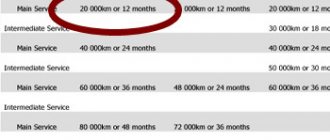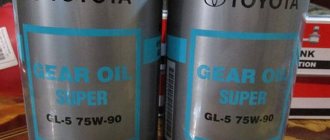Timely oil changes are a prerequisite for the smooth operation of the engine - the heart of the car. And the Toyota Corolla is, of course, no exception.
When and how often is it necessary to change the “working off”? Who should you trust your car to professionals, or, reducing overhead costs, risk changing the oil yourself? Wouldn't such a step be rash, and wouldn't there be dire consequences due to the desire to save money? It is possible that after a careless attitude or out of ignorance, you will have to undertake serious engine repairs. Let’s try to figure out this and other nuances that await owners of a Chorrol car with you.
We carry out the replacement ourselves
One of the factors for the long-term operation of Toyota power unit components is the timely, correct change of “working out”. Almost any driver can carry out such work. To do this, you need to have a simple set of tools and follow a certain sequence.
To prevent a simple procedure from turning into agony, it is necessary, first of all:
- Put the car on a lift or drive a hole, the video at the bottom of the article shows a method that can be used if there is neither a hole nor a lift.
We lift the car onto a lift or drive it into a pit - Have a container for draining the waste.
Drain the used oil
To perform technical actions you should have at hand:
- Oil filter wrench.
- Rags.
- Latex gloves.
- Lighting equipment (for example, a flashlight or “carrying”).
- Wrench for the drain hole nut.
- And, of course, it is necessary to strictly observe all safety measures.
Which oil to choose
One of the most popular questions is what kind of oil to fill in a Toyota Corolla. The best option is to use the oil recommended by the car manufacturer. In the technical description of the machine you can find all the necessary information. Toyota engine oil guarantees maximum service life and will effectively lubricate and cool engine parts. The only drawback is the high price of the original products.
If you don’t want to overpay, you can take a closer look at products from brands such as Mobil, Shell, Castrol, Genuine. It is recommended to use synthetic or semi-synthetic oils. They have many advantages, in particular:
- Resistant to temperature changes.
- They have better fluidity at low temperatures.
- They have less volatility.
- Characterized by increased durability.
- Retain their characteristics longer.
Mineral-based products are suitable for older vehicles up to 2000.
Don't forget to remove the oil filter
Finding exactly where it is installed is not difficult. We wipe its body with a rag, then loosen the fastening manually or with a key, turning it slightly. Let the waste flow freely until it is completely drained. The Corolla oil filter is being replaced with a new one.
Oil filter
It is NOT ALLOWED to install a new filter on an old O-ring in the seat!
Avoid mistakes: there is no need to pour oil into it when changing the filter on a Corolla car.
Replacing the air and cabin filter TOYOTA COROLLA E140 E150
Air filter
It is recommended to change it after 10-12 thousand kilometers; usually this procedure occurs along with an oil change. On the model with a 1.4 liter engine. / 1.6 l. filters are the same.
To replace the air filter we recommend: filter TOYOTA 178010D060
Or a worthy analogue: filter SAKURA A 3301
Cabin filter
According to the manufacturer's recommendations, the cabin filter in TOYOTA COROLLA should also be changed after 10–15 thousand kilometers. On the model with a 1.4 liter engine. / 1.6 l. filters are the same.
To replace the cabin filter, we recommend: filter SAKURA CAC 1114
Or a worthy analogue: filter ASAKASHI AC-108J
Replacing the air filter in TOYOTA COROLLA E140 E150 yourself Video
Replacing the TOYOTA COROLLA air filter is a simple procedure that can be performed by any car enthusiast.
Video “Step-by-step instructions for replacing the TOYOTA COROLLA air filter”
Replacing the cabin filter in TOYOTA COROLLA E140 E150 yourself Video
Replacing the TOYOTA COROLLA cabin filter is a simple procedure that can be performed by any car enthusiast.
Video “Step-by-step instructions for replacing the TOYOTA COROLLA cabin filter”
Filling with engine oil
Pour new oil into the engine
On the power unit of the Corolla car, pour new oil through the filler neck. We check the quantity using the Toyota car manual. We give it some time to wait, putting away the working tools and used rags. We start the engine at low speed.
Then the power unit is checked using a “carrying tool” or a flashlight for possible oil leaks. If everything is fine, the car can be lowered from the overpass or removed from the pit.
On a flat surface, use a dipstick to check the fluid level in the internal combustion engine. If it is clear that the added oil is not enough (look at the dipstick marks), then add it to the required level.
This simple procedure has a number of pitfalls in the form
- Poor or incorrect installation of the filter.
- Weak nut tightening.
- Poor quality oil filling.
Preparatory stage
The process of changing consumables in a Toyota Corolla car is not too complicated; it is only important to understand the principle of the procedure, know the basics and consistently follow the instructions. Experts recommend that you be especially careful about those machines that were manufactured abroad; as practice shows, their parts should be looked after carefully, which will significantly extend the service life of movable property. Only branded oils should be poured into the power unit of a Toyota Corolla car; this recommendation is given by the manufacturer in the machine’s operating manual.
Oil for Toyota Corolla must definitely be of high quality; many experts prefer to use original substances. This type of fluid is called “Toyota Motor oil”. As a rule, it can be found in many automobile service centers and stores. Naturally, this liquid can be purchased from an official dealer; you should not neglect ordering the necessary goods via the Internet.
The Toyota Corolla engine should be filled with a volume of oil that corresponds to its cubic capacity. Toyota Corolla, as a rule, is equipped with power units that have a volume of about 4.2 liters. (everything will depend not only on the year of manufacture of the vehicle, but also on the configuration). Many experienced motorists base the issue of the volume of new oil required on the amount of drained oil.
If this is the first time a motorist is pouring oil into a Toyota Corolla, it would be a good idea to read the operating instructions. The developed manual will help to unambiguously answer all the questions of concern; it clearly indicates the volume of the internal combustion engine, according to which any motorist will be able to calculate the required amount of oil. More detailed information can be obtained from the service book, however, it is best to focus on 4.2 liters.
It is equally important to know the period after which the oil should be changed in a Toyota Corolla car. Motorists who operate this vehicle should take into account that such consumables are replaced every 10 thousand km. However, you should not adhere to these recommendations if the car owner begins to notice malfunctions in the operation of his car; as a rule, they are often caused by the use of low-quality material. In this case, it is better to replace consumables in advance by replacing the used oil and filter.
Checking the gearbox oil level
When operating vehicles, the level of transmission oils in manual transmissions decreases, so in addition to replacement, they should also be topped up regularly. Reasons to check the level are any signs of change in transmission performance. Checking the level and then adding oil are simple operations that you can do yourself.
Work order:
- The car must be placed on a flat horizontal surface above the inspection hole or raised using a lift. Checking the level should be done no earlier than 10 minutes after the vehicle has come to a complete stop, with the engine turned off.
- The surface of the gearbox should be cleaned around the level plugs and breather to prevent dirt from getting inside.
- Unscrew the cap and be sure to wipe it clean.
- Check the oil level - it should reach the bottom edge of the level plug hole.
- If the level is insufficient, unscrew the breathing valve (breather) located at the top of the manual transmission.
- Topping up should be done through the hole in the breathing valve in small portions until oil flows out of the hole for the level plug. For topping up, you can use a funnel and a suitable sized hose.
- Screw the plug into place and tighten it with the required force.
- Reinstall the breather.
Chevrolet Tahoe
Sat Dec 14, 2019
Contents1 Chevrolet Tahoe: advantages1.1 Related articles The luxury car Chevrolet Tahoe attracts a huge amount of attention while driving. And this is completely justified, because its main advantages are a spacious interior, well-thought-out equipment, and fairly economical fuel consumption. It has a beautiful appearance because only the best specialists and high-quality parts work on the design. […]
Categories
Factors affecting engine wear
Engine Toyota Corolla 2008
Toyota Corolla is a car with a fast and good engine. Therefore, it is necessary to know the reasons that affect the service life of the lubricant, and regularly follow the replacement schedule in order for the motor to serve for many years. There are several dozen factors that negatively affect engine oil, which entails increased wear of the internal combustion engine. I would like to highlight the main ones:
- The car has been idle for a long time or not used regularly. It would seem that the car has been standing for two months, what could happen to it? In fact, the system should be started at least once a week. In this case, it requires a special approach and attention. If the machine is used with significant interruptions, then the lubricant should be replaced more often than for one that drives every day.
- Traveling short distances. The problem with engine wear is that if you often start the car and make short runs throughout the day (for example, from store to store), then it does not always have time to warm up. Accordingly, condensation (in simple words – acid) collects in the internal part, which corrodes and negatively affects its operation. This can also be attributed to problematic situations - traffic jams, when the car is moving in the “start-stop” mode, in this case the liquid overheats and gradually loses its beneficial properties.
- Air pollution. It is this factor that, in our country, greatly influences wear and tear. Do you notice that the streets and roads are very dusty? And all this dust gets through the air filter, right into the very “heart”. In our area, it is best to use high-quality filters.
- Vacuum lubricant replacement. As strange as it may sound, modern express oil changes are much worse than the traditional method. After vacuum “running”, part of the old waste fluid remains on the walls and at the bottom of the engine sump. This sediment negatively affects the further operation of the engine.
The frequency of oil changes is up to you. A specific answer to the question: “How often to replace?” - No. The “mileage” of a lubricant is measured in kilometers (on average 8-10 thousand) or months (3-6 months). Each car owner has his own individual calculation of this interval.
Tools
Before you begin the oil change procedure, you need to prepare the appropriate tools, accessories and auxiliary materials. In general, in addition to new motor oil, their list includes:
- a special oil filter puller (belt or chain) or a wrench for removing the oil insert cap (code 09228-06501);
- funnel;
- oil filter or insert;
- socket wrench (head) 14;
- screwdriver;
- container for draining old auto lubricant (at least 5 l);
- latex gloves;
- rags.











